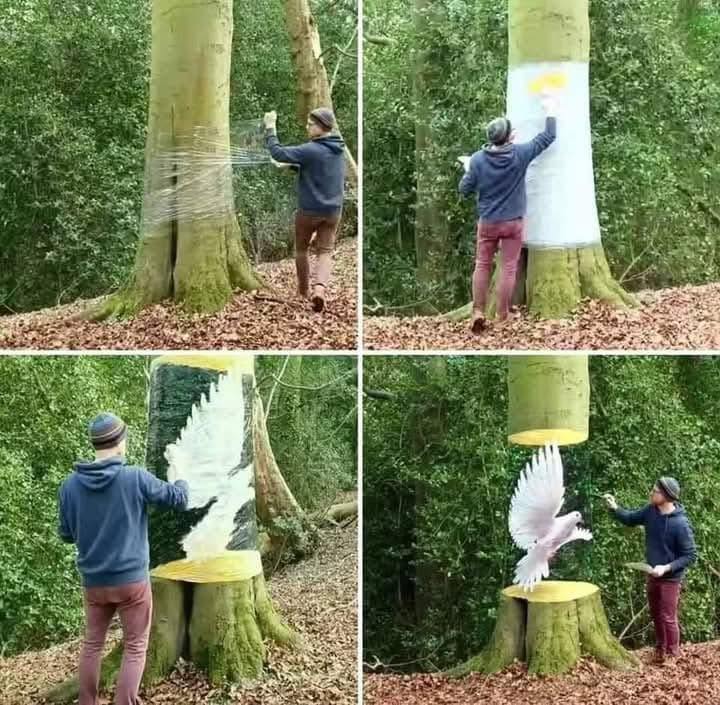In the world of art, creativity knows no bounds, and some artists push the limits of traditional mediums in extraordinary ways. One such visionary is Howard Lee, an artist who has redefined nature-inspired art by transforming tree trunks into breathtaking 3D masterpieces—all while ensuring that the trees remain unharmed and continue to thrive.

The Artistic Vision of Howard Lee
Howard Lee, a self-taught artist and environmental advocate, has developed a unique technique for carving intricate, lifelike 3D sculptures into tree bark. His creations, ranging from detailed animals and expressive human faces to mesmerizing abstract patterns, have captivated art lovers and environmentalists alike. What makes his work truly remarkable is that he meticulously ensures that the trees remain healthy, allowing them to grow naturally while also serving as living canvases.
Lee’s journey into this distinctive form of art began modestly, but over time, he discovered a profound connection between creativity and the natural world. Inspired by the idea of merging art with sustainability, he started experimenting with carving techniques that would highlight the beauty of trees without causing them harm. His process is highly meticulous and considerate, utilizing specialized methods that enhance the tree’s aesthetics while preserving its vitality.
The Story Behind the Art
Howard Lee’s inspiration for his 3D tree trunk carvings stems from a lifelong passion for both art and conservation. As a child, he spent countless hours sketching trees and wildlife in the forests near his home, developing a deep appreciation for nature’s intricate beauty. As he grew older, his love for the environment only intensified, and he sought meaningful ways to use his artistic talents to contribute positively to the world around him.
One defining moment came when Lee was hiking through a wooded area and noticed the naturally textured bark of a centuries-old tree. He wondered: could a work of art be created directly on a living tree without harming it? Through persistent experimentation, he found that by using precise carving tools and refined techniques, he could craft intricate, raised designs on the surface of the bark while ensuring that the tree remained unharmed. His process allows the tree to continue absorbing nutrients, growing naturally, and even healing over time.
How It Works: Carving Without Harm
Lee’s approach requires a delicate balance between artistic craftsmanship and scientific understanding. Unlike traditional wood carving, which often involves deep cuts and structural alterations, his method is much more delicate. He avoids using heavy machinery or deep incisions, instead employing fine carving tools to gently etch his designs onto the bark’s surface. These carvings remain shallow enough to prevent interference with the tree’s ability to transport water and nutrients, ensuring that its health is never compromised.
He carefully selects strong, mature trees for his projects, ensuring that they can withstand the minor surface modifications. Older, well-established trees are ideal candidates, as they are more resilient to light alterations. Furthermore, he adheres to strict ethical guidelines, ensuring that his artwork complements and enhances the tree’s natural beauty rather than diminishing it.
Career Highlights and Notable Projects
Howard Lee’s 3D tree trunk art has garnered worldwide recognition, with some of his most celebrated works displayed in public parks, nature reserves, and private collections. One of his standout projects involved carving the faces of historical figures into a centuries-old oak tree in a community park. This masterpiece seamlessly blended history, art, and nature, earning admiration from both locals and visitors while promoting sustainable artistic practices.
Another remarkable project saw Lee collaborating with environmental organizations to raise awareness about deforestation. He created a series of intricate carvings on endangered trees, using his artwork to highlight the importance of conservation while celebrating their natural splendor. This initiative resonated deeply with environmental activists and art enthusiasts alike, drawing much-needed attention to the fragile state of the world’s forests.
The Moral Behind the Art
While Howard Lee’s work is undeniably stunning, it carries a deeper message. His art serves as a powerful reminder that humans and nature can coexist harmoniously. In an era increasingly affected by deforestation and environmental degradation, Lee’s tree trunk art underscores the importance of preserving natural beauty while also showcasing it through artistic expression.
Moreover, his work challenges traditional notions of art by redefining the boundaries between nature and creativity. By using living trees as his canvas, he invites us to reconsider our relationship with the environment, proving that the most profound artistic expressions emerge when we choose to work with nature rather than against it. His legacy is one of both artistic excellence and environmental responsibility—a testament to how art can inspire change while celebrating the beauty of the world around us.





